You’re about to discover flowering succulents that transform from understated plants into spectacular displays of color and form. While most people think succulents only offer interesting shapes and textures, these varieties pack a surprising punch with their blooms. From the fiery red spikes of crown of thorns to the delicate cascades of string of hearts, each plant reveals its hidden talent at different times throughout the year. Let’s explore these remarkable specimens that’ll revolutionize your indoor garden.
Contents
- 1 1. Crown of Thorns
- 2 2. String of Hearts
- 3 3. Easter Cactus
- 4 4. Burro’s Tail Succulent
- 5 5. Jewel-Toned Kalanchoe
- 6 6. Echeveria
- 7 7. Desert Rose
- 8 8. Jade Plant
- 9 9. Moonstone Succulent
- 10 10. Paddle Plant
- 11 11. Mexican Fire Barrel
- 12 12. Living Stone
- 13 13. Aloe
- 14 14. Ice Plant
- 15 15. Stapelia
- 16 16. Christmas Cactus
- 17 17. Prickly Pear Cactus
- 18 18. Baby’s Necklace
- 19 19. String of Buttons
- 20 20. Wax Plant
1. Crown of Thorns
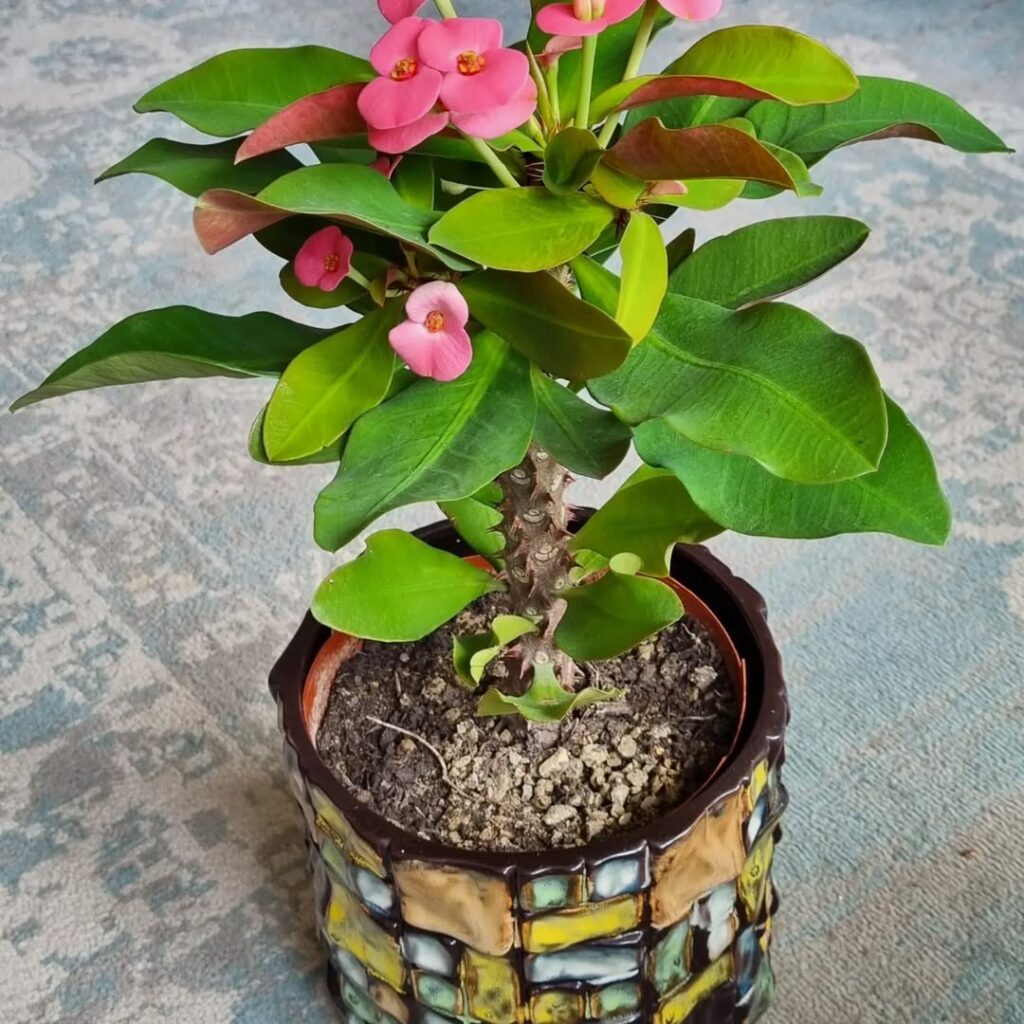
Crown of Thorns (Euphorbia milii) is a charming succulent known for its vibrant, long-lasting blooms and thorny stems. This Madagascar native produces small, colorful flowers surrounded by showy bracts in shades of red, pink, yellow, or white that can bloom year-round when properly maintained. The plant features thick, spiny stems and oval-shaped leaves, growing as a shrub that can reach heights of 3-6 feet. Despite its intimidating thorns, Crown of Thorns is relatively easy to grow and makes an excellent indoor plant or outdoor specimen in warm climates.
- Light: Bright, direct sunlight for at least 4-6 hours daily; can tolerate partial shade but blooms best in full sun
- Water: Allow soil to dry between waterings; water deeply but infrequently; reduce watering in winter
- Soil: Well-draining cactus or succulent mix; can add extra perlite or sand for better drainage
- Temperature: Prefers 65-75°F (18-24°C); protect from frost
- Humidity: Tolerates average household humidity; adapts well to dry conditions
- Fertilizer: Light feeding with balanced fertilizer during growing season
- Container: Must have drainage holes; terra cotta pots work well
2. String of Hearts
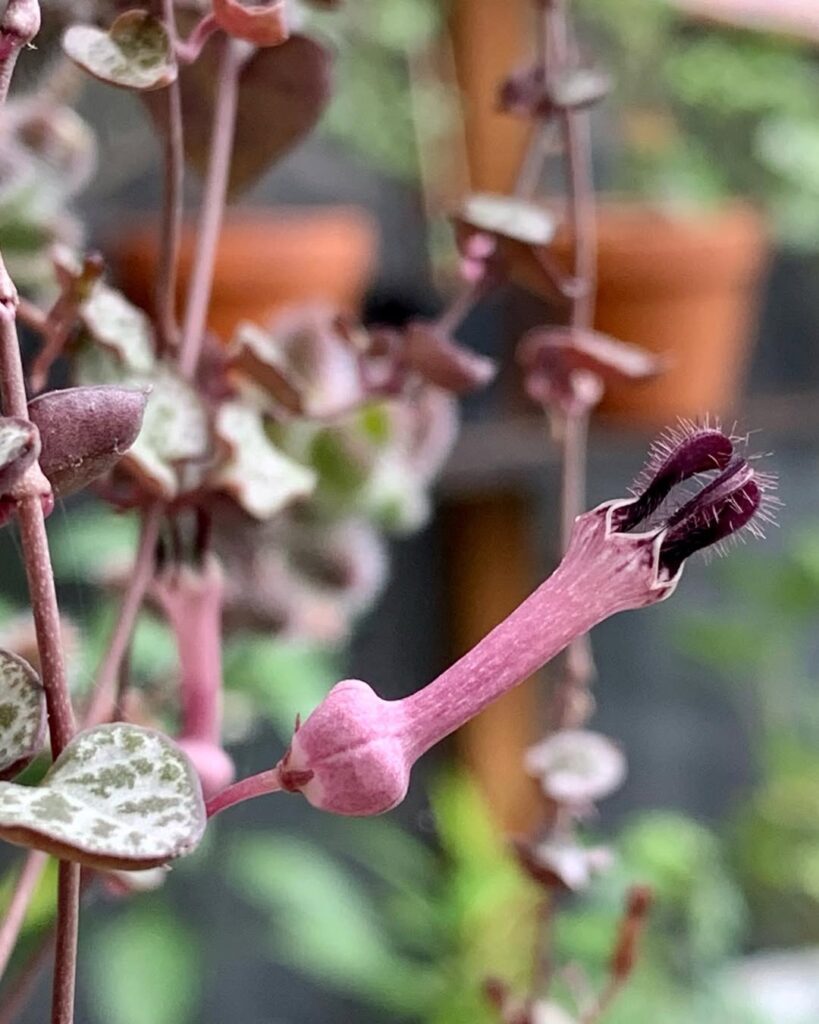
The String of Hearts (Ceropegia woodii) is a trailing succulent known for its delicate, heart-shaped leaves featuring intricate silver marbling patterns on deep purple-green foliage. This charming plant produces small, tubular flowers in pink to purple hues, though it’s primarily grown for its distinctive cascading vines that can reach several feet in length. Native to South Africa, it’s a popular choice for hanging baskets and high shelves where its vines can elegantly drape.
- Light: Bright, indirect light; can tolerate some direct morning sun
- Water: Allow soil to dry between waterings; reduce watering in winter
- Soil: Well-draining succulent or cactus mix
- Temperature: 65-80°F (18-27°C)
- Humidity: Average household humidity; tolerates dry conditions
- Container: Pot with drainage holes
- Fertilizer: Feed with diluted succulent fertilizer during growing season
- Propagation: Stem cuttings or rooting tubers
3. Easter Cactus
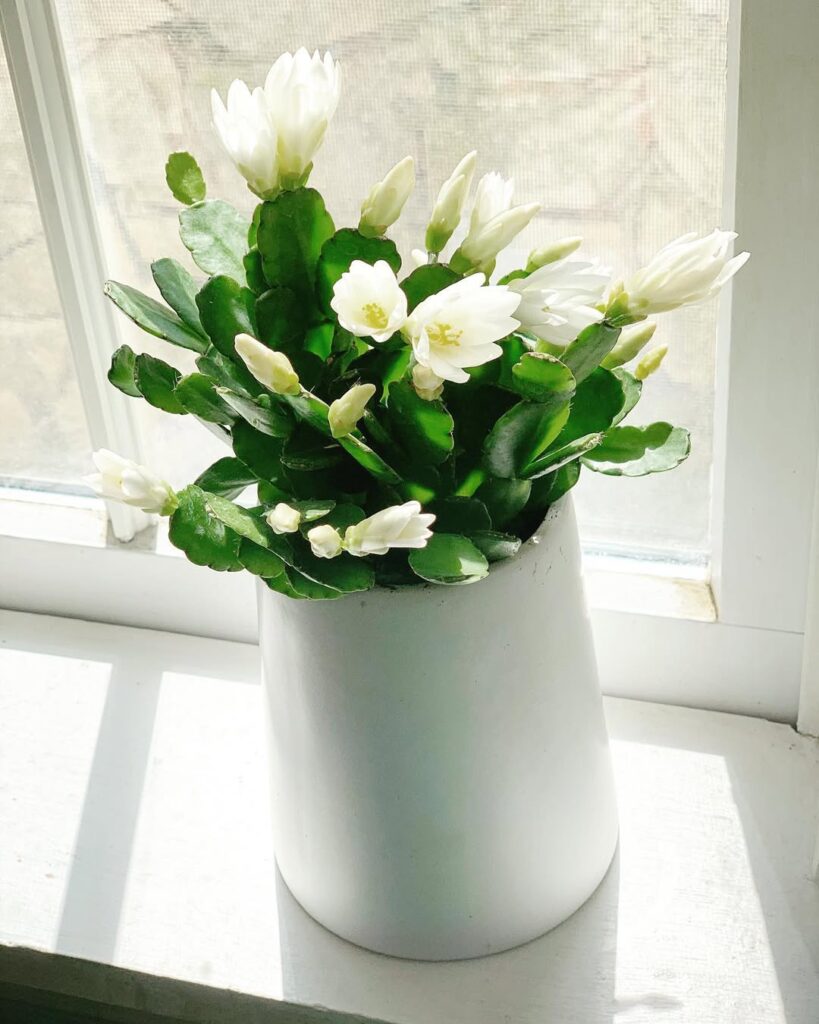
The Easter Cactus (Hatiora gaertneri) is a flowering succulent known for its vibrant spring blooms in shades of pink, red, or white. Unlike its holiday-blooming cousins, the Christmas and Thanksgiving cacti, Easter Cactus typically flowers around Easter, hence its common name. The plant features flat, fleshy stem segments with rounded edges and produces star-shaped flowers at the tips of its branches. Each bloom can last for several days, and under ideal conditions, the plant may flower multiple times throughout the year.
- Light: Bright, indirect light; protect from harsh afternoon sun; some morning sun is beneficial
- Water: Allow soil to dry partially between waterings; reduce watering in winter
- Soil: Well-draining potting mix with added perlite or orchid bark
- Temperature: 60-75°F (15-24°C); cooler nights in winter to promote blooming
- Humidity: Moderate to high humidity (50-60%)
- Fertilizer: Feed monthly with balanced fertilizer during growing season
- Pot: Use containers with drainage holes
- pH: Slightly acidic soil (5.5-6.5)
4. Burro’s Tail Succulent
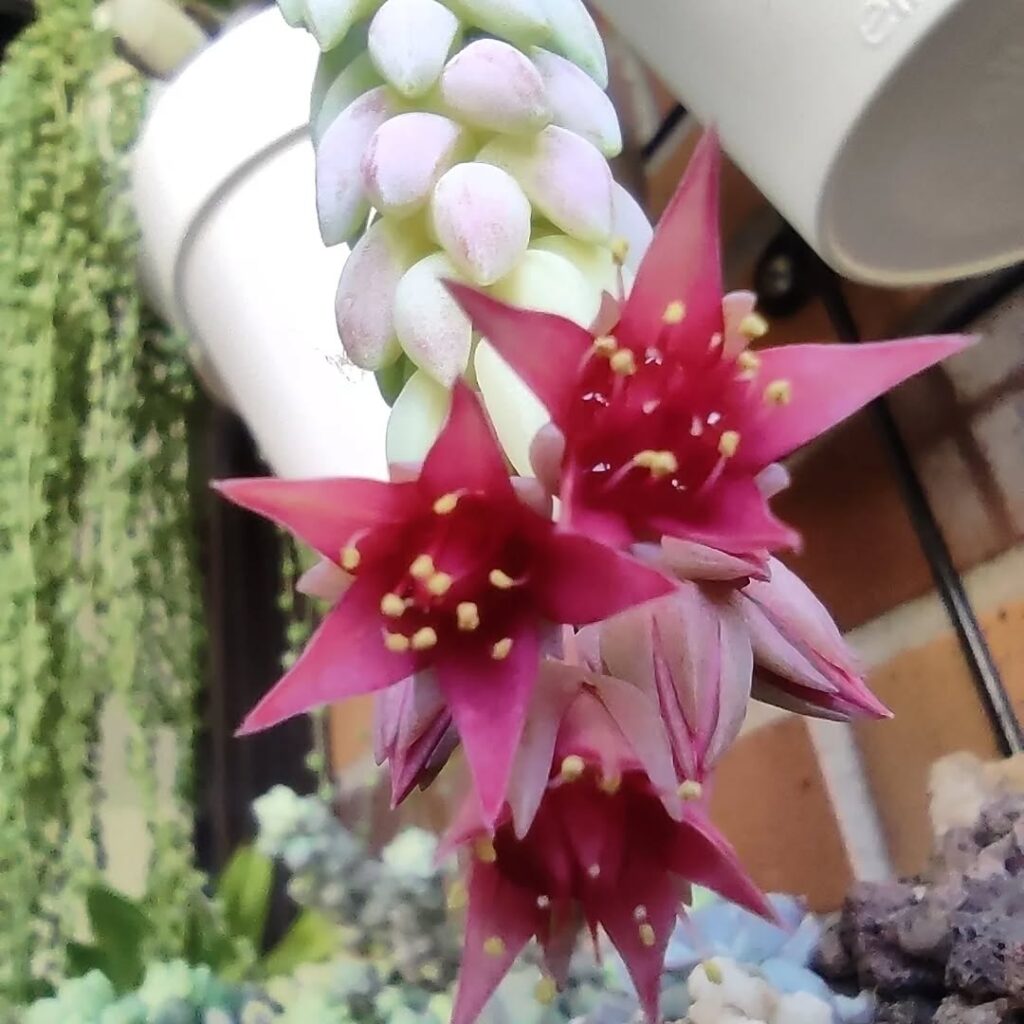
The Burro’s Tail Succulent (Sedum morganianum, also known as Donkey’s Tail) is a trailing succulent with long stems covered in plump, pearl-like leaves that overlap to create rope-like strands. These stems can grow up to 4 feet long and feature bluish-green to gray-green leaves arranged in a dense spiral pattern. When in bloom, it produces small pink or red flowers at the ends of its stems, though flowering is relatively rare in indoor cultivation.
- Light: Bright, indirect sunlight; can tolerate some direct morning sun but needs protection from harsh afternoon rays
- Water: Allow soil to dry completely between waterings; reduce watering in winter
- Soil: Well-draining cactus or succulent mix
- Temperature: Ideal range between 65-75°F (18-24°C)
- Humidity: Tolerates average household humidity
- Container: Hanging basket or container with drainage holes
- Propagation: Easily propagated from fallen leaves or stem cuttings
- Fertilizer: Light feeding with balanced fertilizer during growing season
5. Jewel-Toned Kalanchoe
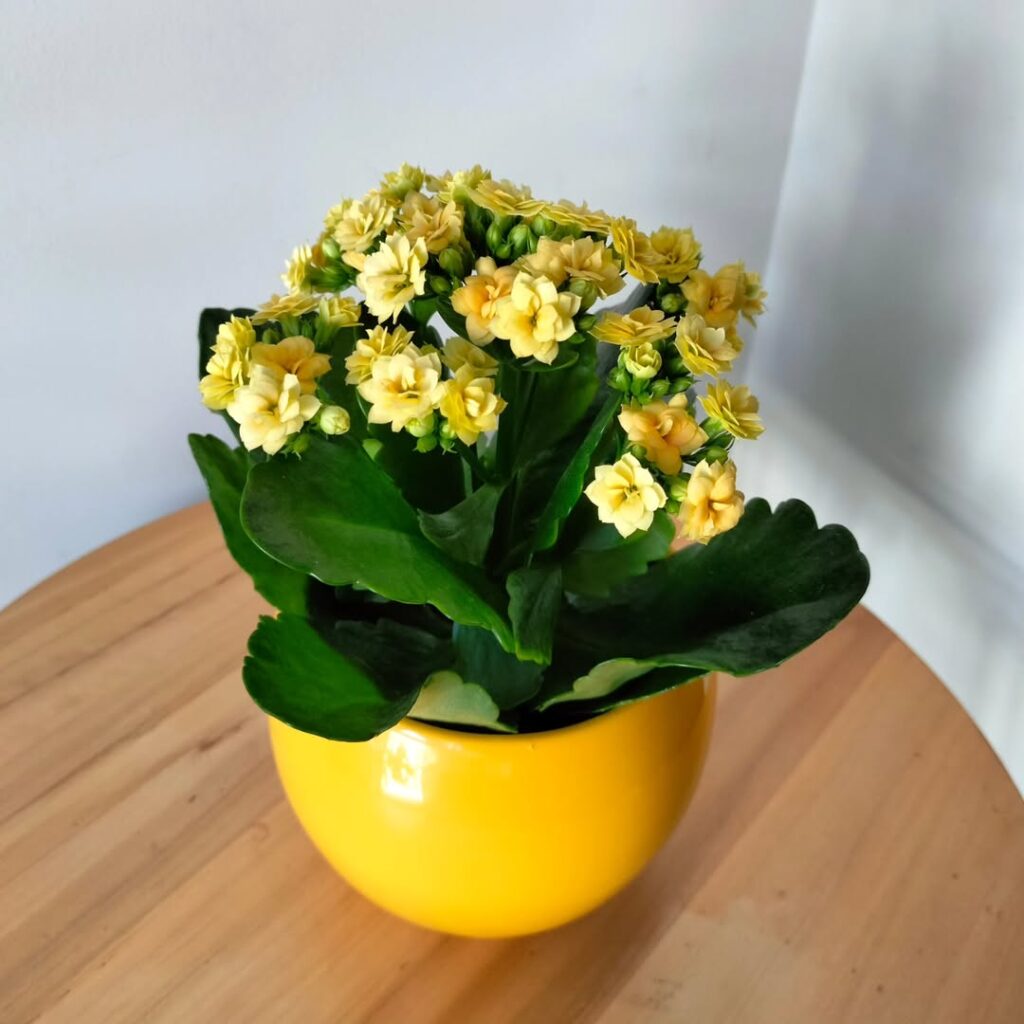
The Jewel-Toned Kalanchoe is a vibrant flowering succulent known for its clusters of small, long-lasting blooms in rich colors like deep red, orange, pink, and yellow. These compact plants typically grow 8-12 inches tall and feature thick, scalloped dark green leaves that provide an attractive backdrop for the showy flower clusters. Native to Madagascar, Kalanchoes have become popular houseplants due to their easy care requirements and ability to bloom for several weeks, particularly during winter and early spring.
- Light: Bright, indirect sunlight; protect from intense afternoon sun; at least 6 hours of light daily
- Water: Allow soil to dry between waterings; reduce watering during winter; avoid overwatering
- Soil: Well-draining cactus or succulent mix
- Temperature: 60-75°F (15-24°C)
- Humidity: Tolerates average indoor humidity
- Fertilizer: Feed monthly with balanced fertilizer during growing season
- Container: Pot with drainage holes
- pH: 5.8-6.3
6. Echeveria

Echeveria flowers emerge from tall, arching stalks that rise above the plant’s rosette, creating an ethereal display of delicate, bell-shaped blooms. These luminous flowers typically appear in shades of orange, pink, yellow, or red, and their vibrant colors contrast beautifully with the succulent’s pastel-hued leaves. The flowering stems can reach heights of 8-12 inches, producing multiple blossoms that last for several weeks during spring and summer months.
- Light: Bright, indirect sunlight with some direct morning sun; protect from harsh afternoon sun
- Water: Allow soil to dry completely between waterings; reduce watering during flowering
- Soil: Well-draining cactus or succulent mix with added perlite
- Temperature: 65-80°F (18-27°C)
- Humidity: Low to moderate; tolerates dry air well
- Fertilizer: Light feeding with balanced fertilizer during growing season
- Container: Pot with drainage holes to prevent root rot
- Growing Season: Spring through summer
- Dormancy: Semi-dormant in winter
7. Desert Rose
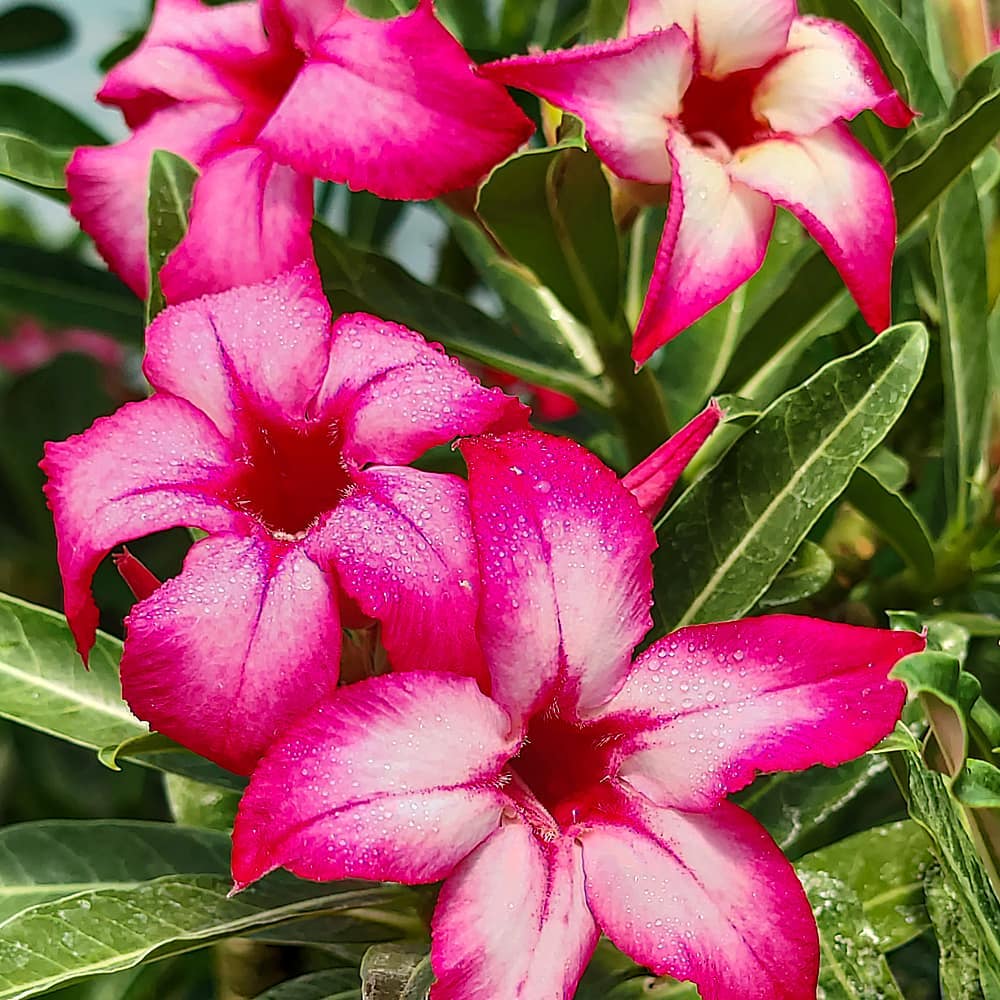
The Flaming Desert Rose (Adenium obesum) produces stunning clusters of red, pink, or white trumpet-shaped flowers that create a vibrant display against its thick, twisted stems and glossy green leaves. These eye-catching blooms appear multiple times throughout the growing season, typically lasting several weeks each time. The flowers measure 2-3 inches across and feature delicate, overlapping petals that give them their distinctive star-like appearance.
- Light: Full sun to partial shade; minimum 6 hours direct sunlight daily
- Water: Moderate watering during growing season; reduce considerably in winter
- Soil: Well-draining cactus mix or sandy soil with added perlite
- Temperature: 65-90°F (18-32°C); protect from frost
- Humidity: Tolerates low humidity
- Fertilizer: Monthly feeding with balanced fertilizer during growing season
- Container: Deep pot with drainage holes to accommodate tuberous root system
- Growing Zone: USDA zones 10-12
8. Jade Plant
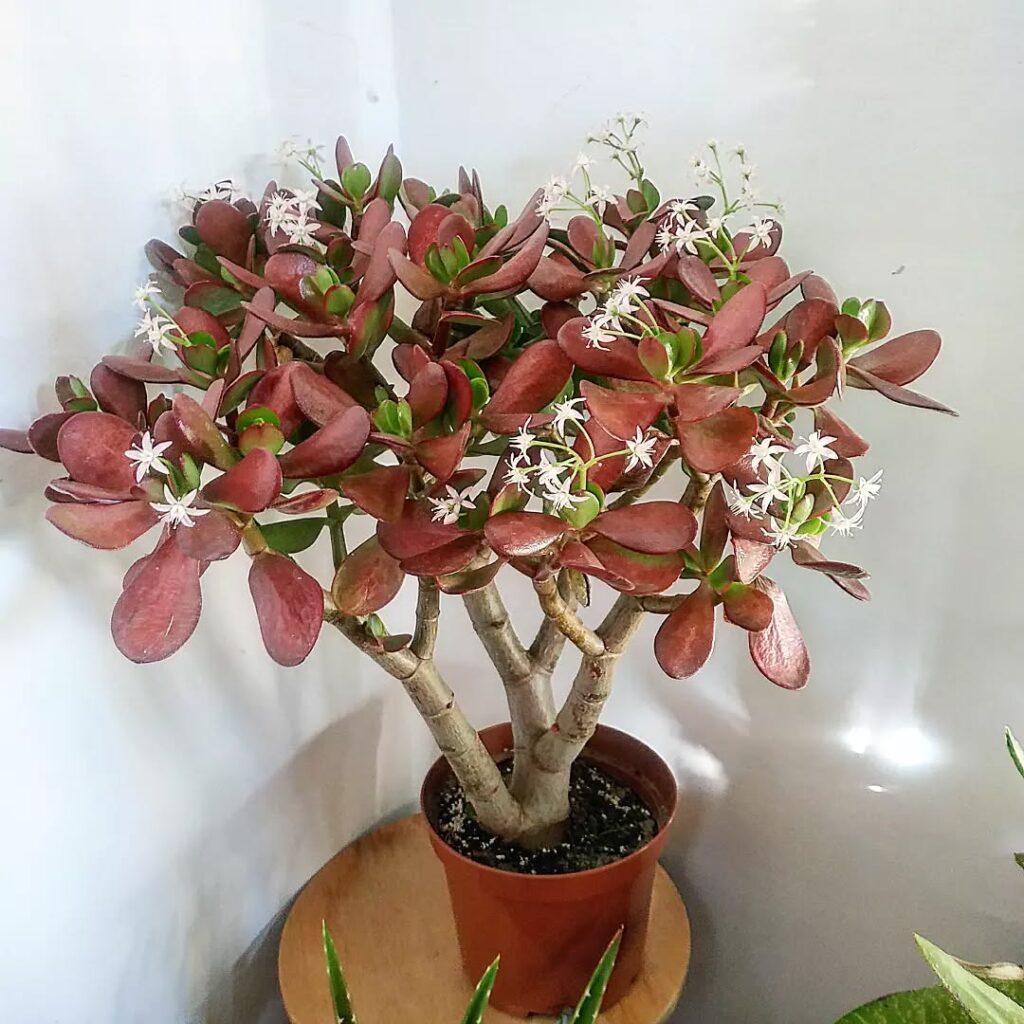
Majestic Jade (Crassula ovata) produces clusters of small, star-shaped pink or white flowers during winter to early spring. These delicate blooms emerge from the thick, rounded leaves of the plant, creating a striking contrast against its jade-green foliage. While not all Jade plants flower regularly in cultivation, mature specimens grown in ideal conditions can reward gardeners with an impressive display of dainty blossoms that attract pollinators and add visual interest to the succulent garden.
- Light: Bright, indirect sunlight with 4-6 hours of direct morning sun; protect from intense afternoon sun
- Water: Allow soil to dry completely between waterings; reduce watering in winter
- Soil: Well-draining cactus or succulent mix with added perlite or coarse sand
- Temperature: 65-75°F (18-24°C); can tolerate down to 50°F (10°C)
- Humidity: Tolerates average household humidity; prefers dry conditions
- Fertilizer: Feed with balanced, water-soluble fertilizer at quarter strength during growing season
- Potting: Use containers with drainage holes; repot every 2-3 years
9. Moonstone Succulent
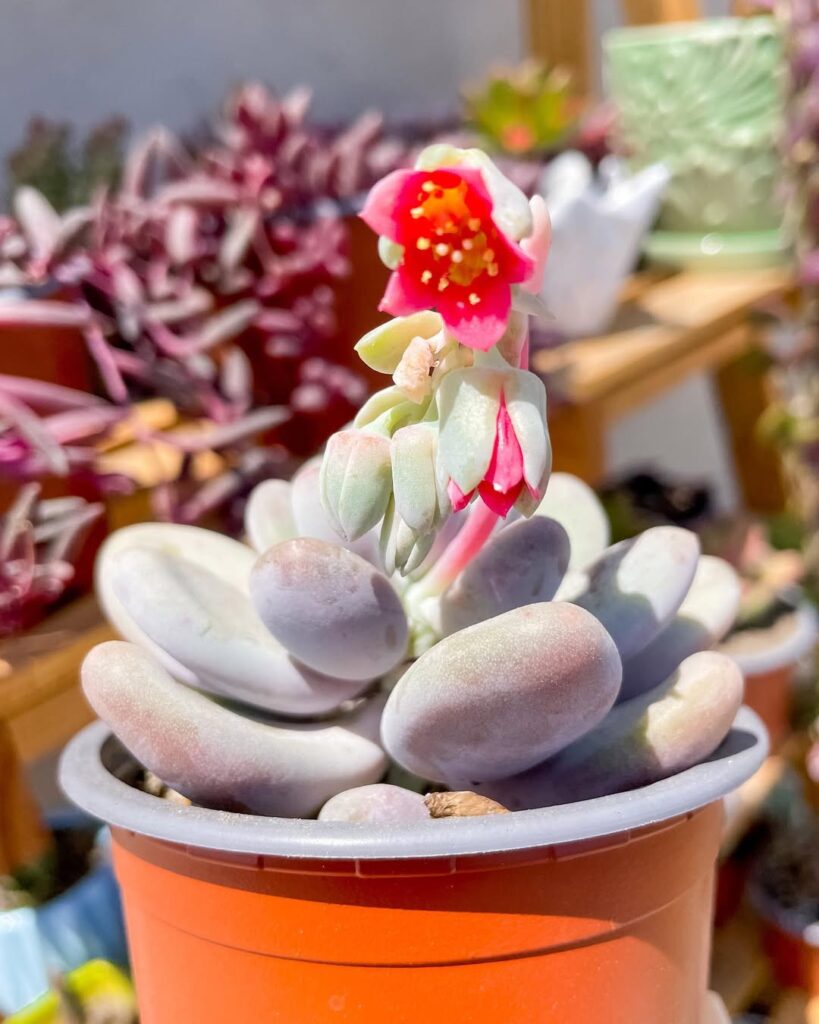
Moonstone (Pachyphytum oviferum) produces delicate clusters of star-shaped pink flowers that emerge from rosettes of plump, oval leaves. These small blossoms appear on thin stalks during late winter to early spring, creating an ethereal display against the plant’s powdery blue-gray foliage. The flowers typically measure about half an inch across and form in loose clusters of 4-8 blooms, attracting pollinators like bees and butterflies to the garden.
- Light: Bright, indirect sunlight with some morning sun; protect from intense afternoon sun
- Water: Allow soil to dry completely between waterings; reduce watering during winter months
- Soil: Well-draining cactus or succulent mix
- Temperature: 65-80°F (18-27°C); can tolerate brief periods down to 40°F (4°C)
- Humidity: Low humidity preferred; tolerates average household humidity
- Fertilizer: Light feeding with balanced fertilizer during growing season only
- Planting Depth: Surface level with roots just below soil surface
- Container: Must have drainage holes and be slightly wider than the plant’s rosette
10. Paddle Plant
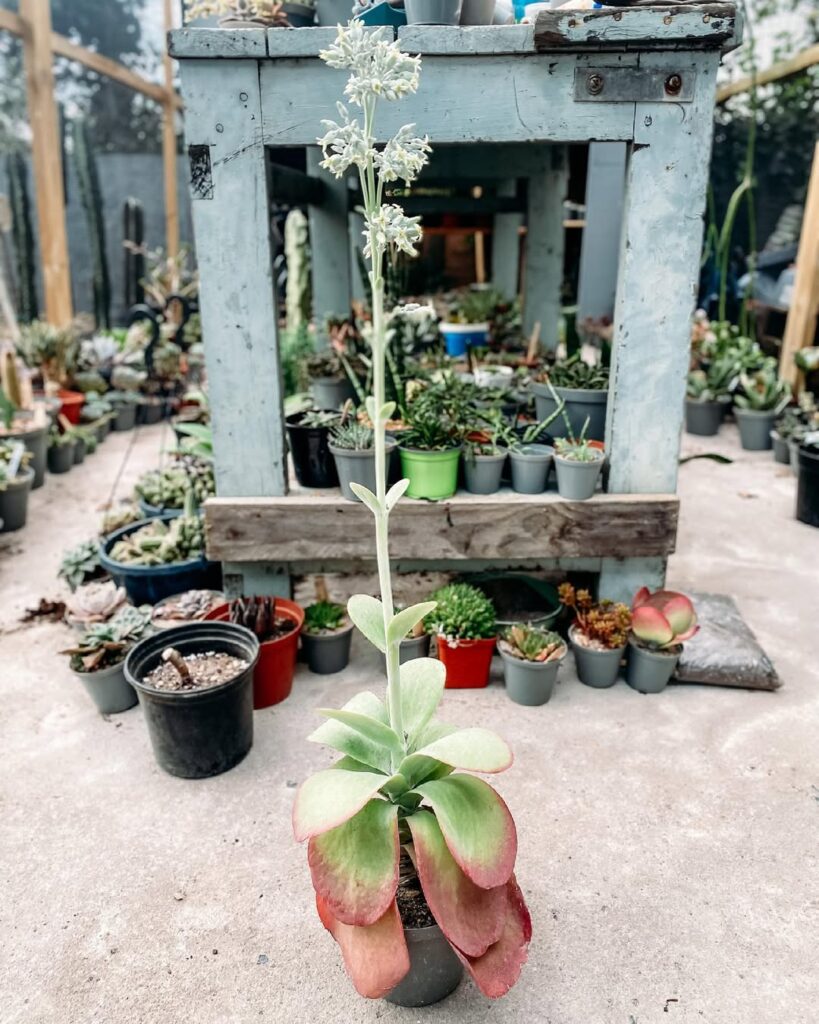
The Pink Paddle Plant (Kalanchoe luciae) is a striking succulent known for its thick, rounded leaves that develop intense pink to red edges when exposed to sufficient sunlight. These plants form rosettes of fleshy, paddle-shaped leaves that grow in opposite pairs, creating a distinctive stacked appearance. During winter months, mature plants may produce tall stalks bearing clusters of yellow, tubular flowers, though the main appeal lies in their colorful foliage, which can reach up to 6 inches in diameter.
- Light: Full sun to partial shade; needs bright light for best color development
- Water: Low water needs; allow soil to dry completely between waterings
- Soil: Well-draining cactus or succulent mix
- Temperature: Hardy in zones 9-11; protect from frost
- Humidity: Tolerates low humidity
- Fertilizer: Light feeding during growing season; none in winter
- Container: Must have drainage holes
- Growing Season: Active growth in spring and summer
- Propagation: Easily propagated through leaf cuttings or offsets
- Indoor/Outdoor: Can be grown both indoors and outdoors in suitable conditions
11. Mexican Fire Barrel
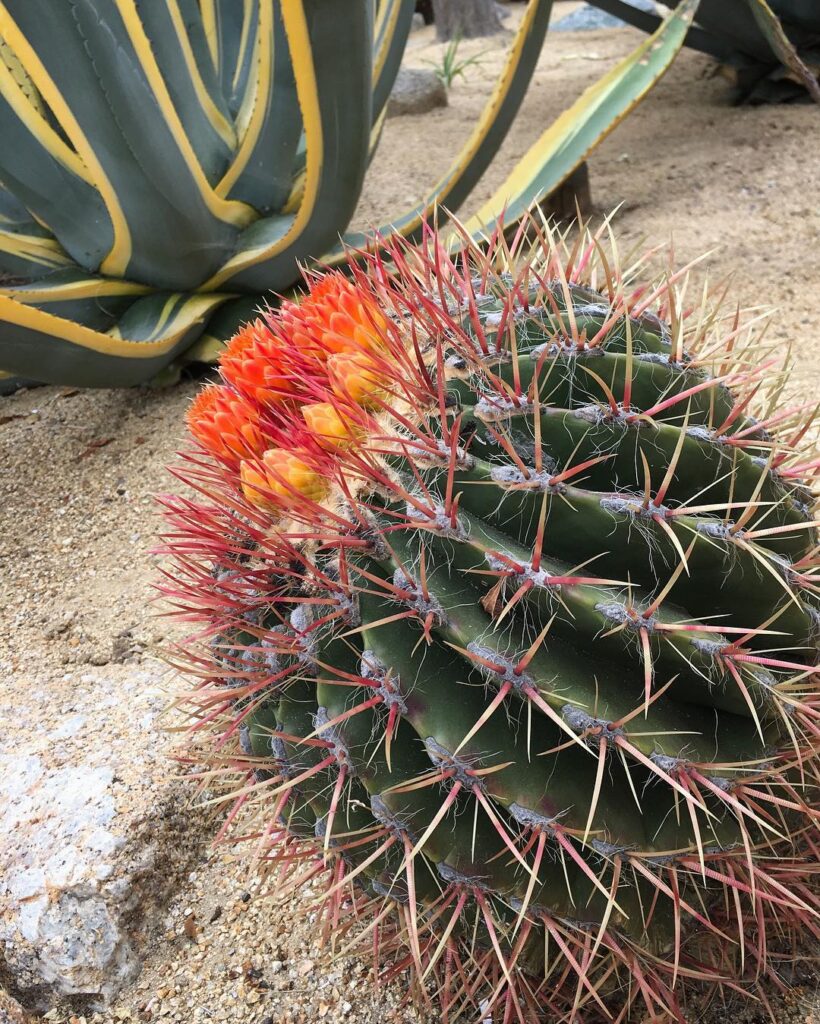
The Blazing Mexican Fire Barrel (Ferocactus pilosus) is a striking barrel cactus known for its vibrant red spines and impressive flowering display. This cylindrical succulent can grow up to 8 feet tall and produces a crown of bright red or magenta blooms during late spring to early summer. Native to Mexico’s desert regions, this cactus develops prominent ribs along its body and is covered in dense, flame-colored spines that give it its common name. The flowers emerge from the top of the plant in a circular pattern, creating a stunning contrast against the reddish spines.
- Light: Full sun exposure; requires at least 6 hours of direct sunlight daily
- Water: Minimal watering needed; allow soil to dry completely between waterings; reduce watering in winter
- Soil: Well-draining cactus mix or sandy soil with added perlite and gravel
- Temperature: Thrives in hot conditions; protect from frost; ideal range 70-100°F (21-38°C)
- Humidity: Low humidity preferred; tolerates dry air well
- Growing Zone: USDA zones 9-11
- Container Requirements: Deep pot with drainage holes; terracotta preferred for better moisture control
12. Living Stone
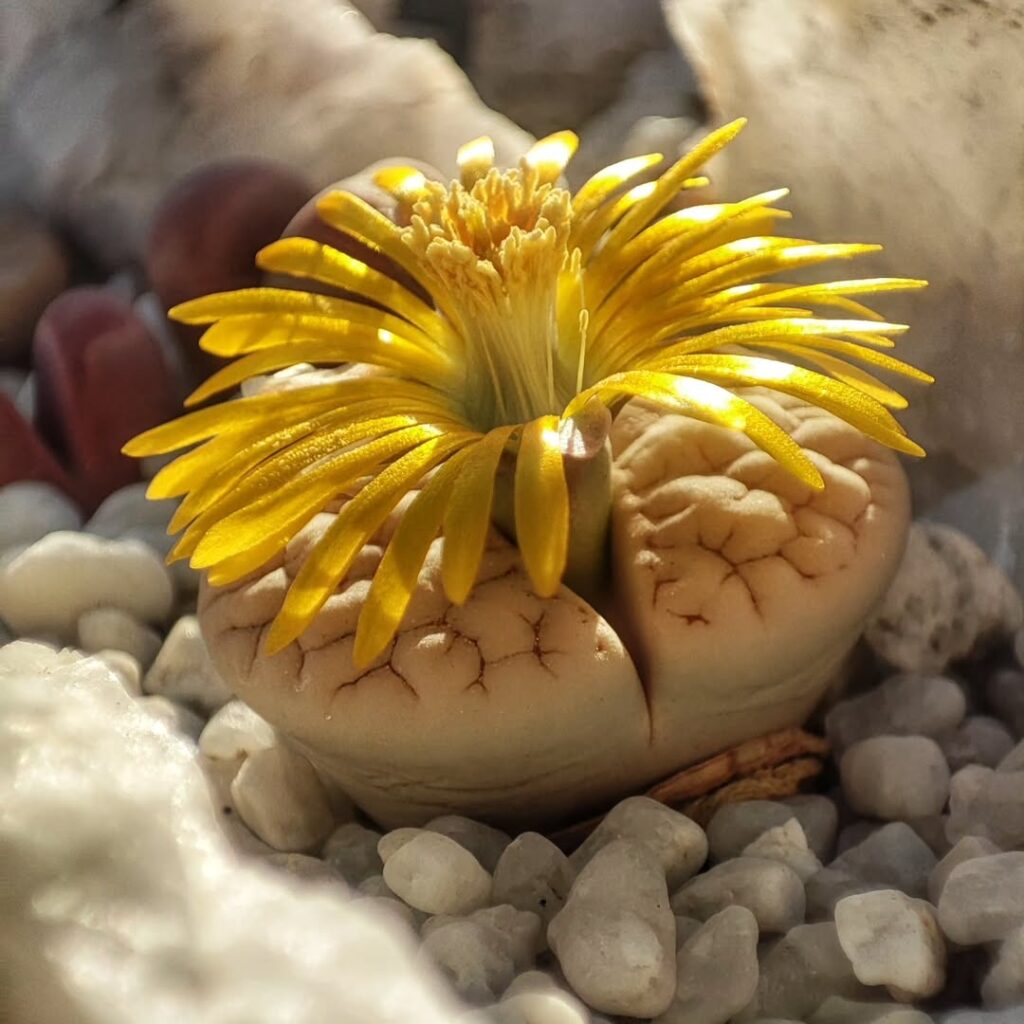
The Living Stone (Lithops) produces vibrant white and yellow-hued blooms that emerge from between its paired succulent leaves during fall or early winter. These daisy-like flowers open in the afternoon and close at night, lasting several days. Each flower emerges from the fissure between the plant’s two thick, stone-like leaves, creating a striking contrast against the typically grayish or brownish plant body.
- Light: Full sun to partial sun; minimum 4-6 hours direct sunlight daily
- Water: Minimal watering; allow soil to dry completely between waterings; reduce water during winter dormancy
- Soil: Fast-draining mineral-rich mix; 70-80% inorganic material (pumice, coarse sand)
- Temperature: 65-80°F (18-27°C); can tolerate brief periods below freezing
- Humidity: Low humidity preferred
- Growing Season: Active growth in spring and fall; dormant in summer and winter
- Container: Well-draining pot with drainage holes; shallow containers preferred
13. Aloe
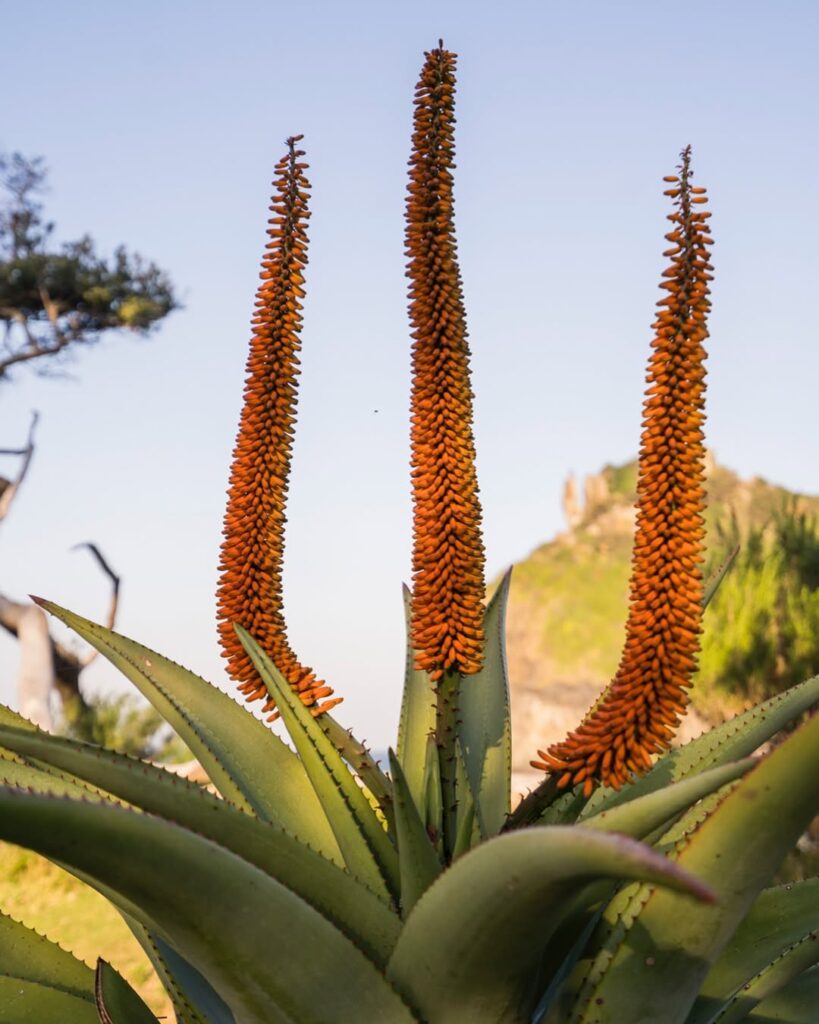
The striking red flower spikes of Aloe plants emerge dramatically from their rosettes of thick, fleshy leaves, typically blooming in late winter to early spring. These torch-like flower stalks can reach heights of 1-3 feet, featuring tubular blossoms in vibrant shades of red, orange, or coral that attract hummingbirds and other pollinators. The blooms appear on tall, branching stems called racemes, with individual flowers clustering densely along the spike in a downward-facing arrangement.
- Light: Full sun to partial shade; minimum 6 hours direct sunlight daily
- Water: Minimal water needs; allow soil to dry completely between waterings
- Soil: Well-draining, sandy or rocky soil mix
- Temperature: 70-80°F (21-27°C); can tolerate brief periods of cold
- Humidity: Low to moderate; tolerates dry conditions
- Fertilizer: Light feeding during growing season; none during winter
- Spacing: 2-3 feet between plants to accommodate flower spikes
- Drainage: Excellent drainage required; raised beds or containers ideal
14. Ice Plant
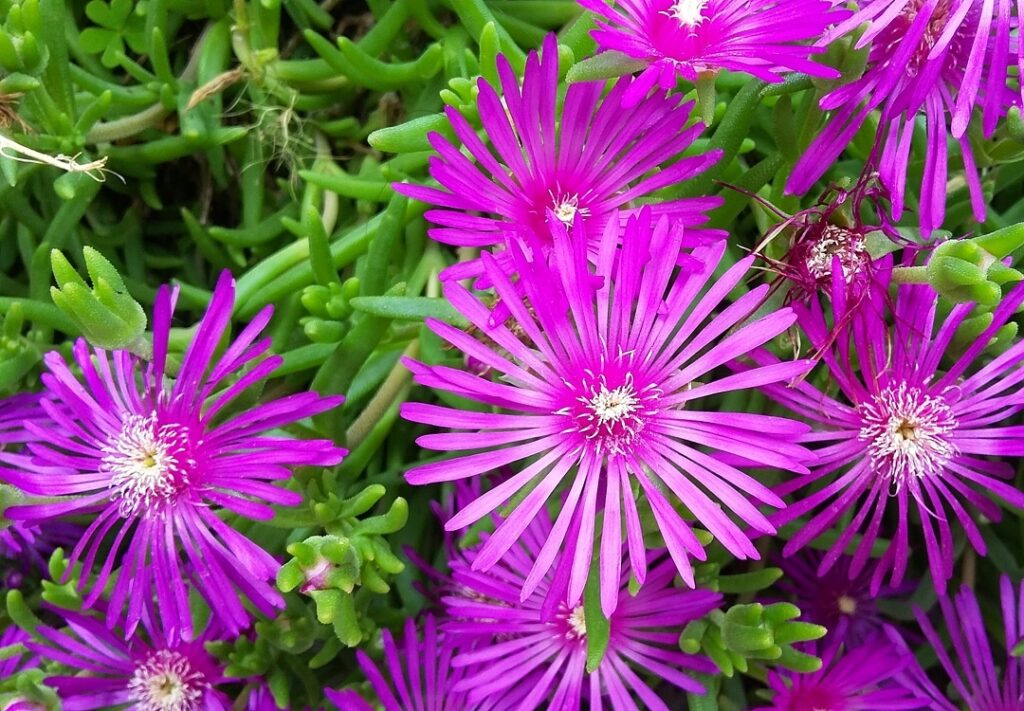
The Hardy Ice Plant (Delosperma cooperi) dazzles with its daisy-like flowers in vivid shades of reddish-purple, blooming from summer into early autumn. These striking blossoms, about 2 inches in diameter, thrive in warm climates and attract pollinators like bees. The succulent foliage, coated in glossy, ice-like flakes, remains evergreen in warmer regions, adding year-round visual appeal.
- Light: Full sun; thrives with at least 6 hours of direct sunlight daily
- Water: Drought-tolerant; deep watering every couple of weeks if no rainfall
- Soil: Well-draining, sandy or gravelly mix
- Temperature: Prefers warm climates; sensitive to extreme cold
- Humidity: Low; tolerates dry conditions
- Fertilizer: Minimal feeding; organic fertilizer before winter if needed
- Spacing: 2 feet apart for optimal spread
- Drainage: Essential; raised beds or containers recommended
15. Stapelia
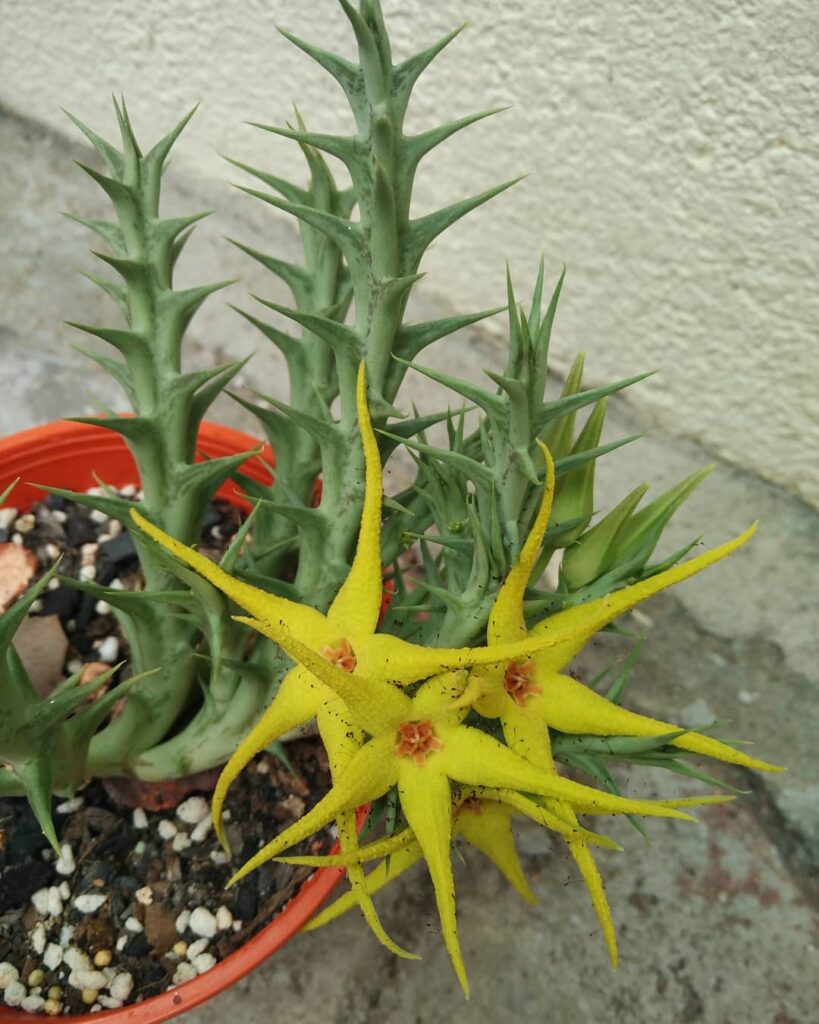
Stapelia succulents produce star-shaped flowers in shades of red, cream, and deep purple, often covered in fine hairs. Blooming during warm months, these unique blossoms sometimes emit a scent to attract pollinators. The fleshy, angular stems develop a reddish hue under sun stress, adding to their ornamental appeal.
- Light: Bright, indirect sunlight; tolerates full sun with protection
- Water: Allow soil to dry completely between waterings; minimal in winter
- Soil: Well-draining, gritty mix with perlite and sand
- Temperature: 50-80°F (10-27°C); protect from frost
- Humidity: Low; thrives in arid conditions
- Fertilizer: Light feeding in spring and summer to encourage blooming
- Spacing: 1-2 feet apart for airflow
- Drainage: Essential; shallow pots with drainage holes ideal
Here’s your refined list with bolded keywords in the main paragraph text while keeping the care conditions unbolded:
16. Christmas Cactus

Christmas Cactus (Schlumbergera spp.) is a beloved houseplant that produces vibrant, tubular flowers in shades of pink, red, white, and orange, typically blooming in winter. Its segmented, arching stems add to its ornamental appeal, making it a festive favorite.
- Light: Bright, indirect light; tolerates some shade
- Water: Keep soil lightly moist but allow drainage; reduce watering in fall
- Soil: Well-draining mix with peat and sand
- Temperature: 60-75°F (15-24°C); protect from frost
- Humidity: Moderate to high; benefits from occasional misting
- Fertilizer: Monthly feeding during growing season for better blooms
- Spacing: 6-12 inches apart for airflow
- Drainage: Essential; avoid waterlogged soil
17. Prickly Pear Cactus
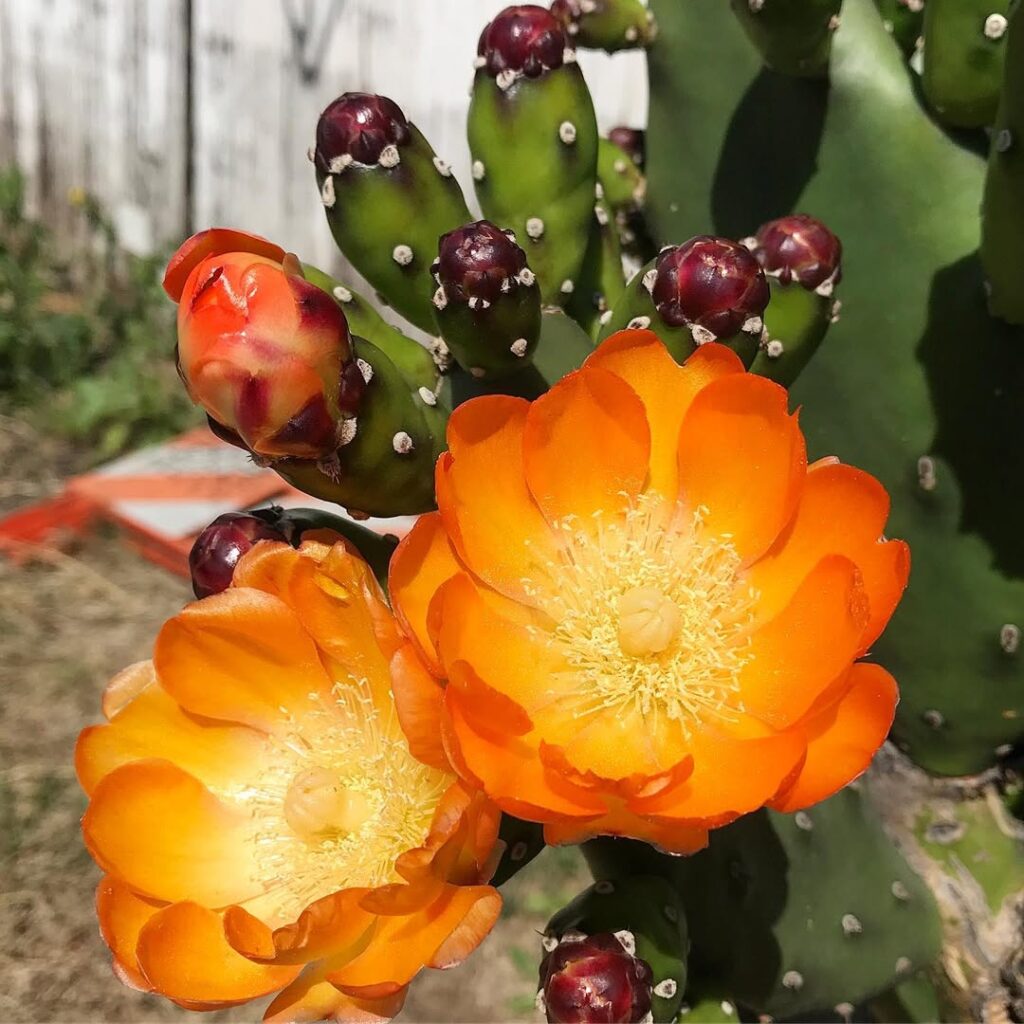
Recognized for its large, showy flowers in shades of yellow, pink, or orange, Prickly Pear Cactus (Opuntia spp.) thrives in arid conditions. Its paddle-like stems are adorned with spines and often bear edible fruits after blooming.
- Light: Full sun for optimal growth and flowering
- Water: Low; drought-tolerant, requiring occasional deep watering
- Soil: Sandy, well-draining mix
- Temperature: 50-90°F (10-32°C); highly heat-resistant
- Humidity: Low; adapts well to dry climates
- Fertilizer: Minimal feeding; occasional nutrients in spring
- Spacing: 2-4 feet apart due to spreading habit
- Drainage: Critical; thrives in dry, rocky soil
18. Baby’s Necklace
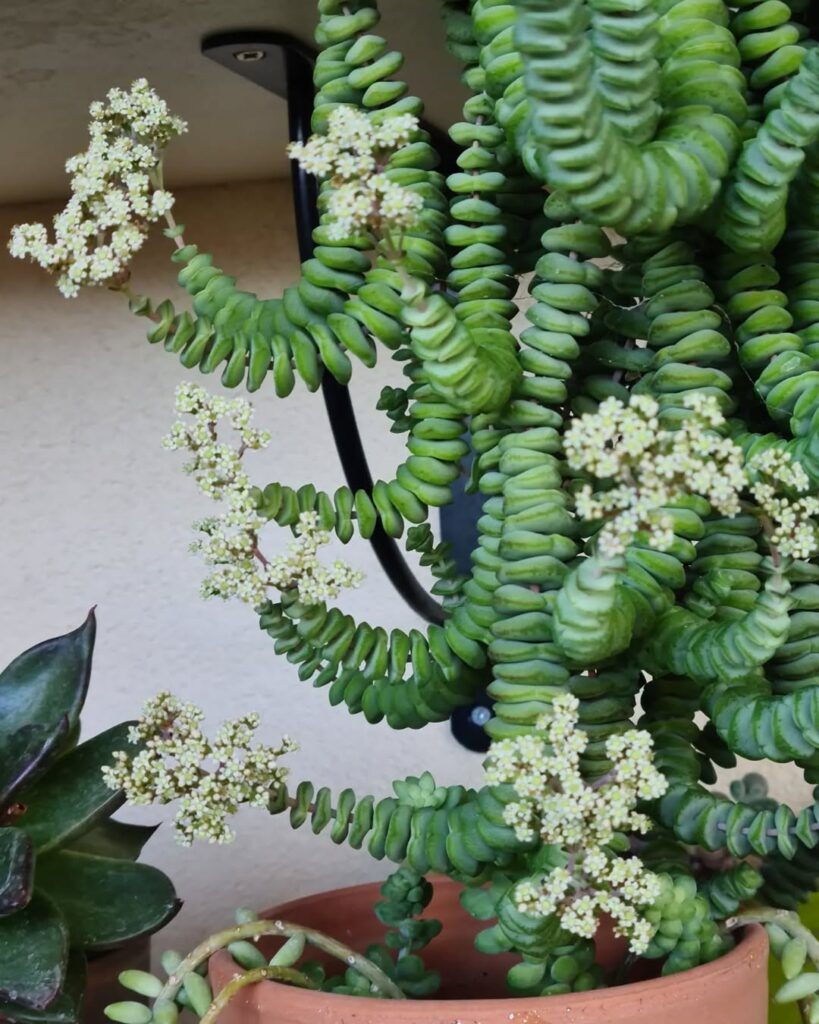
A stacking succulent with tightly clustered, spiraling leaves, Baby’s Necklace (Crassula rupestris) produces cheerful clusters of pink, white, and yellow flowers. Its compact shape makes it ideal for container gardens.
- Light: Bright, indirect sunlight; tolerates some direct sun
- Water: Allow soil to dry completely between waterings
- Soil: Well-draining mix with sand and perlite
- Temperature: 55-80°F (13-27°C); avoid frost
- Humidity: Low; thrives in arid conditions
- Fertilizer: Light feeding in spring and summer
- Spacing: 4-6 inches apart for airflow
- Drainage: Essential; use shallow pots
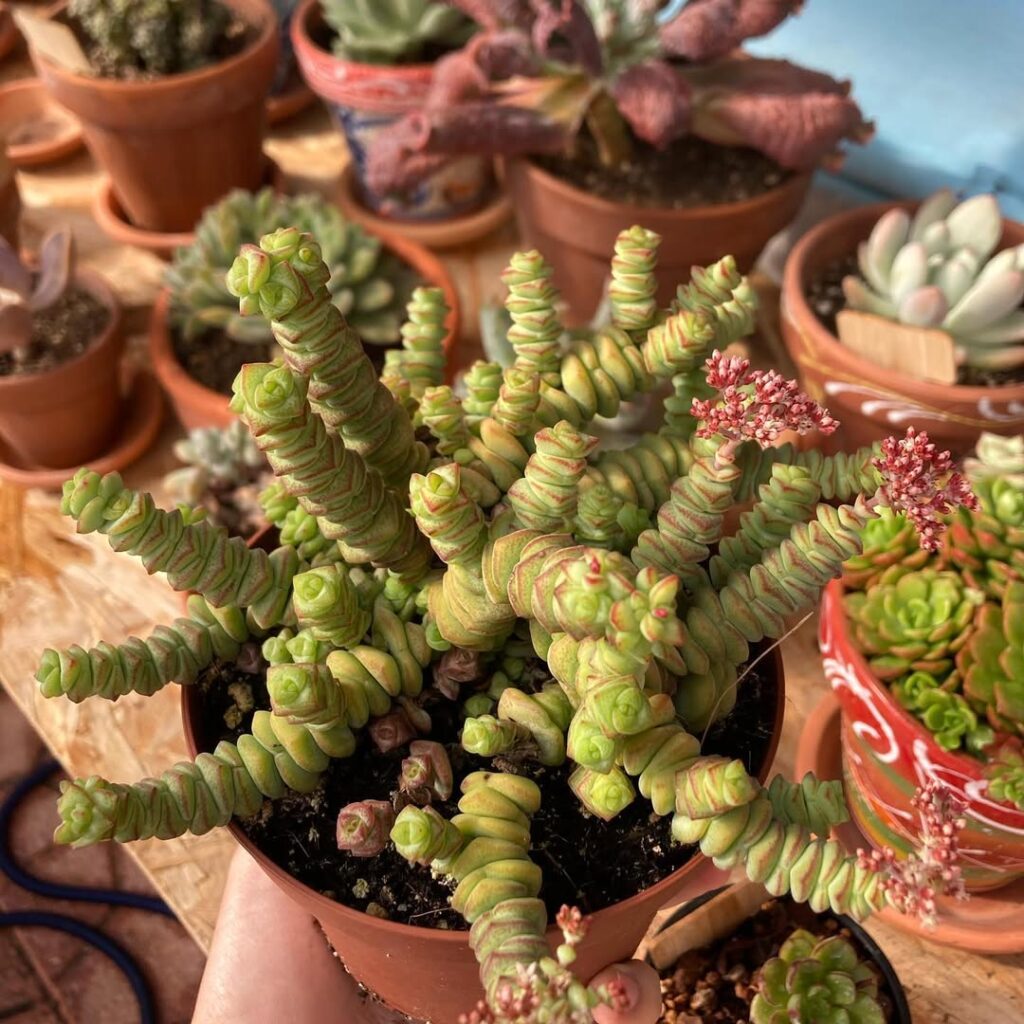
This sprawling succulent (Crassula perforata) features bluish-green leaves with rosy pink margins and produces small white and red flowers, adding charm to hanging baskets and rock gardens.
- Light: Bright, indirect sunlight; some direct exposure beneficial
- Water: Let soil dry completely between waterings
- Soil: Well-draining, gritty mix
- Temperature: 50-80°F (10-27°C); avoid cold drafts
- Humidity: Low; prefers dry air
- Fertilizer: Occasional feeding to boost flowering
- Spacing: 4-8 inches apart to allow growth
- Drainage: Essential; shallow pots ideal
20. Wax Plant
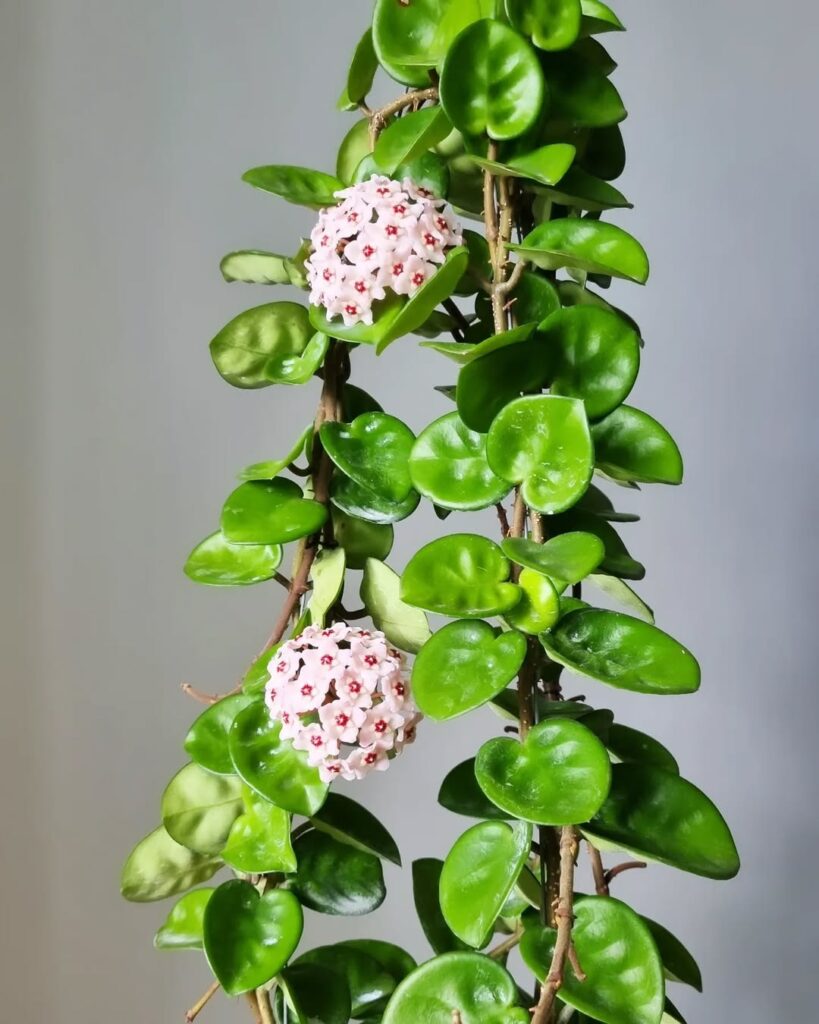
A vining succulent (Hoya spp.) that produces clusters of fragrant, waxy flowers in shades of pink, white, and red, often resembling small stars. Its trailing stems make it great for hanging planters.
- Light: Bright, indirect sunlight; tolerates low light
- Water: Allow soil to dry between waterings
- Soil: Well-draining mix with orchid bark and perlite
- Temperature: 60-80°F (15-27°C); sensitive to cold
- Humidity: Moderate to high; prefers humid conditions
- Fertilizer: Monthly feeding during growing season
- Spacing: Vines can be trained along supports
- Drainage: Critical; avoid soggy soil
